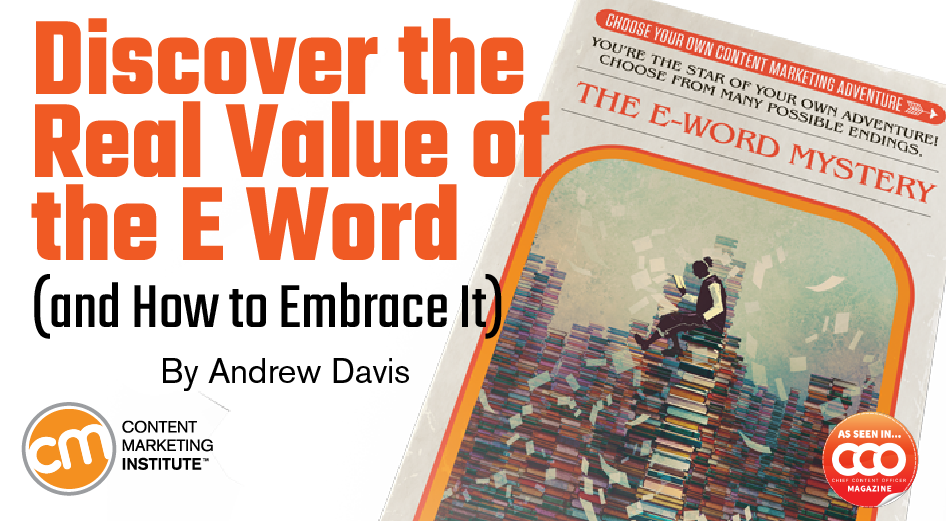At a recent content marketing event, one speaker used the E word 335,000 times in a 45-minute breakout session. What is engagement? How-to videos occupy their audience’s desire to know the answer to a question over time. That’s engagement. So, engaging content should keep the audience chasing answers. When you create how-to content the curiosity gap is obvious: The audience is consciously asking the first question, such as, “How do I tie a bow tie?” The video maintains the viewer’s attention by ensuring that the end of each step invites the viewer to ask, “What’s next?” To maintain your audience’s attention, you must manufacture curiosity gaps. We all know that whatever is behind the click won’t measure up to the expectation the headline sets. If you are to create engaging content (even how-to content), you must build suspense. The crime creates the curiosity gaps, piquing a need for closure with one central question: Who did it? Instead of front-loading your content with answers to every one of the reader’s questions, build suspense by excluding some essential story elements.

“You keep using that word. I do not think it means what you think it means.” – Inigo Montoya, The Princess Bride
For marketers, “that” word is engagement. And we use it a lot.
We use it in strategy meetings, tweets, videos, and blog posts. We’ve selected “creating more engaging content” as one of our top priorities in Content Marketing Institute annual surveys. We’ve listed “engagement” as one of our most important content marketing goals in the very same survey. At a recent content marketing event, one speaker used the E word 335,000 times in a 45-minute breakout session. (OK, I didn’t keep count but she used the word A LOT.)
But what exactly do YOU mean when you say the E word?
Some consider engagement to be the number of shares a piece of content receives. Others believe engagement is the number of visitors to a blog post or the number of views a video receives. Still others claim they measure engagement by tracking the number of comments or conversations that result from a single piece of content. Some count “likes” and “favorites” as proof that their content is engaging.
Chances are your definition of engagement is different from mine, which is different from theirs.
We use the E word so often that, within a marketing context, the word has lost all meaning.
It’s time to fix this.
What is engagement?
According to the Oxford English Dictionary, “engage” means to “occupy or attract (someone’s interest or attention),” while “interest” is the state of “wanting to know or learn about something” and “attention” is “regarding something as interesting or important.”
Marketing engagement is the act of occupying your audience’s desire to know or learn over time. Therefore, if you’re going to measure engagement with your content, you must focus on time-based metrics like time on page or duration of website visit. However, mediums like audio and video have an even better metric for understanding engagement.
Once you hit the play button on a video you’re barreling toward its end with a limited number of options along the way: pause, rewind, fast-forward, stop, and play. As a viewer, you can also bail on the video at any time. Because video is a linear medium, measuring audience engagement is simple: How many people make it to the end?
Getting to the end of a video is essential, as this is where you most often place the call to action. If your “learn more,” “download now,” or “buy now” buttons are the destination and your content consumers never make it to the end of the video, how can you expect them to take action?
YouTube provides one of the most significant engagement metrics of any social platform. Buried in YouTube’s analytics is a simple chart called “audience retention,” comparing the number of views at the beginning of the video with the number of views at the end (or any point in between).

For example, a video with an average audience retention rate of 25% means most viewers watch only 25% of it. A content creator’s ultimate goal is to produce video content with 100% audience retention (meaning the average viewer watches the entire video). That would be a genuinely engaging video. Why? Because, remember, engagement is defined in marketing as occupying your audience’s desire to know something over time. The longer you retain your viewers, the more engaging your content.
What type of video gets highest engagement?
After researching hundreds of videos over the last two years, I’ve learned one type of video typically has the highest audience retention rates: how-to videos. For example, the world’s most-consumed bow-tie tutorial video has millions of views and most of those viewers make it all the way to the end. By definition it’s engaging.
But why do good how-to videos have such high audience retention rates? The viewer has a question, “How do I tie a bow tie?” and the video has the answer. However, if you want to tie a bow tie successfully you can’t bail on the how-to video halfway through. You can’t skip a step. You have to watch the entire tutorial.
How-to videos occupy their audience’s desire to know the answer to a question over time. That’s engagement.
So, engaging content should keep the audience chasing answers.
But what about all the other content you create? How do you make it engaging?
How do you keep your audience curious?
There are two compelling psychological phenomena at work when we consume any piece of content. Not only do these mental factors explain…

COMMENTS